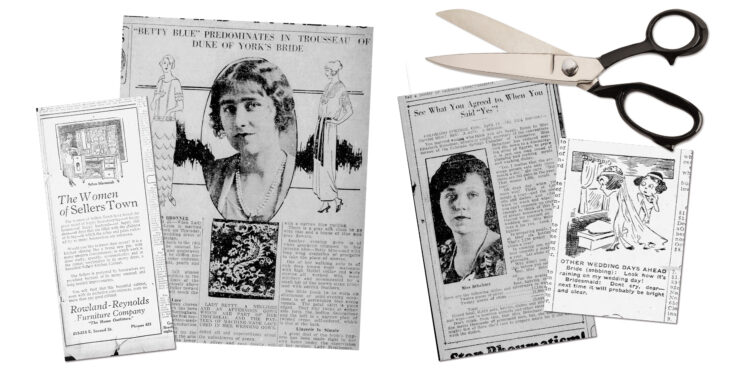Never mind the fairytale nuptials of Lady Diana and Prince Charles. The wedding of the century had already taken place, way back in 1923.
Every aspect of the ceremony uniting Lady Elizabeth Bowes-Lyon to the Duke of York was examined in the pages of newspapers around the world, including those published right here in Owensboro.
This included samples of the lace featured in “Lady Betty’s” trousseau (now there’s a word you don’t see much anymore!), including (gasp!) her negligee.
The wedding gown itself, described as a “simple medieval design” dating back to the 14th century, was made of a chiffon moire in an “old ivory color, embroidered with pearl beads, pearls and silver lame,” and was designed to “fall almost straight from the shoulders to the hem, following the lines of the figure more or less closely above the waist, but getting fuller toward the hem.” The skirt, articles promised, would touch the toes.
Bridesmaids’ dresses, the bride’s going-away dress and her afternoon gown were also described in painstaking detail.
The royal trousseau, newspapers trumpeted, were destined to be copied in England and America. The influence of Lady Betty would be seen in hats, shoes, handkerchiefs, gloves and the smallest of accessories, as well as gowns and frocks – the latter of which, articles promised, “are not difficult to copy.”
Even the colors most preferred by this Scottish maid, now a royal princess, were destined for popularity. “Betty blue” and a soft gray would be seen everywhere that summer and fall, a tribute to the “Fourth Lady in England” and the “First Lady in Style.”
Well, perhaps brides now, as well as then, seek inspiration among celebrities, but in the meantime, young ladies being married in Owensboro in 1923 were not at all lacking in style on their wedding days.
A glance at any of the society pages published in 1923 reveals a fashionista’s paradise, as well as descriptions of ceremonies that surely rivaled that of Lady Betty’s in extravagance.
Flowers of all types – roses, pink cosmos, valley lilies, dahlias, carnations, orange blossoms and more – lent their fragrances to these affairs.
The sound of music also filled the air! The traditional “Wedding March” by Mendelssohn was, of course, a favorite, but also popularly featured were “Ava Maria,” “Hymn of Love” and “O Promise Me.”
Bridal gowns and those of bridesmaids featured white satin crepe, long court trains, embroidered silk shawls, bustle drapes and beaded bodices.
Receptions, whether breakfasts or luncheons, were a cornucopia of delights. Some of the highlights of the 1923 season included ice molded in the form of apples, grapes and peaches, and three-tier cakes.
Many of those happy young couples went on to become our ancestors, setting an example of marriage as a partnership and blessing.
However, not everyone was so enamored of love! An article published in the Messenger-Inquirer on April 15, 1923, quoted a “blissfully single” woman from Colorado who shared a dire warning with potential brides to consider the consequences of marriage – specifically, a lifetime of preparing meals and washing dishes.
“Oh, drab day when you were wed!” the article moans. What’s more, “If you can’t summon up courage enough to think of this heap of greasy housework you contracted for yourself on your wedding day,” Miss Elizabeth Belschner helpful supplies the math, calculating the housewife of an average family of four was doomed to wash 41,610 pots, kettles, dishes and silverware a year on a conservative estimate (not counting utensils and other “extras”).
“Married bliss? Bah! A myth. A delusion,” the author threatens.
Not to worry, however! Then as now, commerce to the rescue!
An advertisement published in the Owensboro Messenger on May 20, 1923, by the Rowland-Reynolds Furniture Company (213-215 E. Second St., Phone 431) had the answer.
The secret of happy housekeeping, happy homes, happy husbands, happy children was … a Kitchen Cabinet.
Yes, this cabinet, with its exclusive conveniences, promised to rid the housewife of aches and pains, making work easier, speedier and more systematic.
Now that’s what we might call a fairy tale. OL










